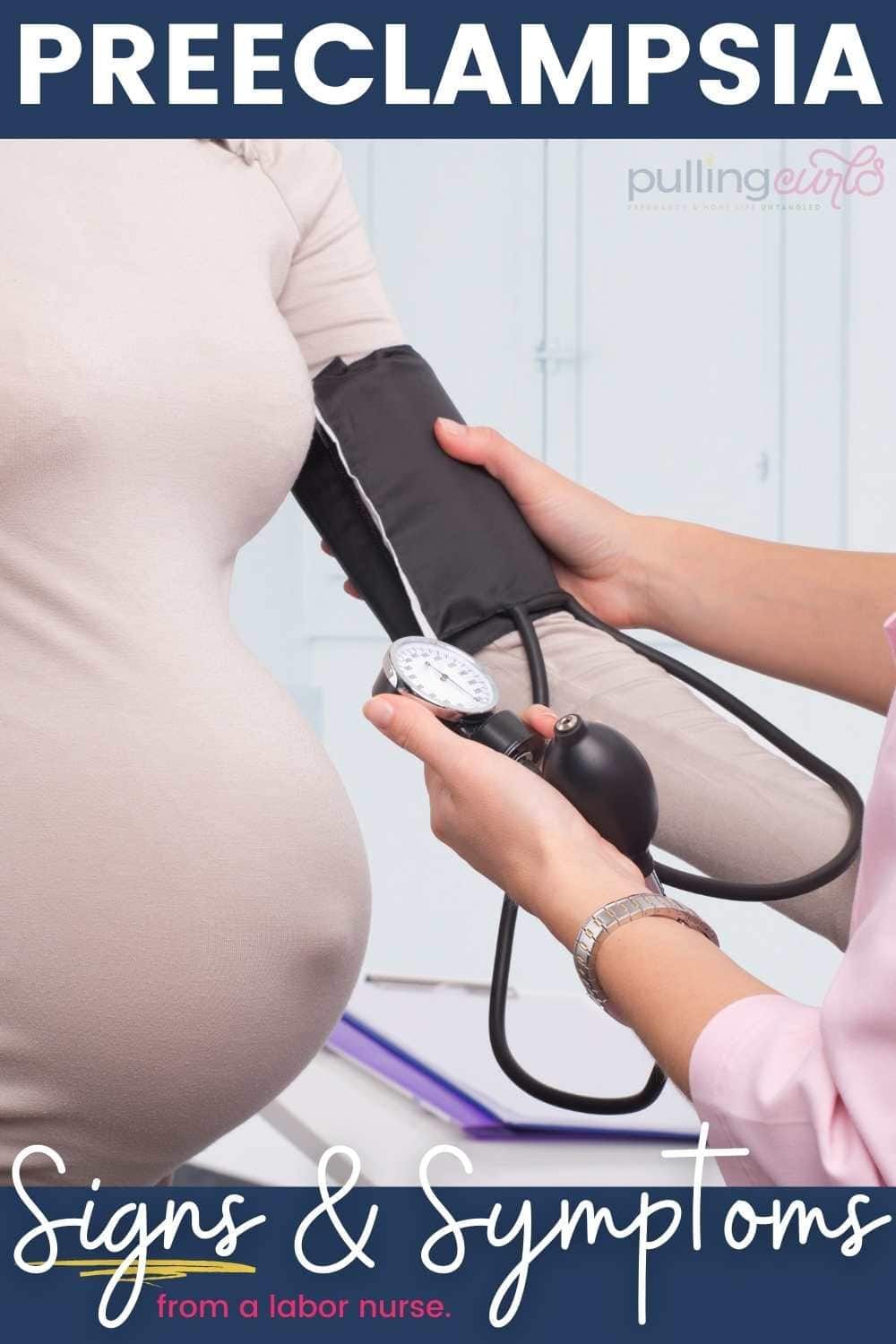Preeclampsia Signs: Preeclampsia can be a scary complication of pregnancy. We’re going to talk labs, prevention, why it sometimes happens postpartum, when it occurs, how it may affect the baby and what causes it.

**Please do not take any information given here in lieu of your doctor’s advice. You pregnancy is special and you need to listen to YOUR doctor’s advice. This is just information to help you hopefully understand it better. You can’t make your own diagnosis of preeclampsia by anything you’ve read on the internet, leave that to your doctor. AND, most importantly, PLEASE pick a doctor you trust!
A note from Hilary (a labor nurse since 2001): This post was written after I attended a seminar on Preeclampsia. It is written just like I heard it, so I could get the information across. It’s a serious thing, and I like to make sure my readers are informed.
This article can be a bit overwhelming, I have a post with 5 things you need to know about preeclampsia that boils it down a bit more. It’s a bit more on how this can apply to every pregnant woman — rather than going into how it all works and is treated.
Preeclampisa
What is Preeclampsia?
- It is a multi-system organ dysfunction that ONLY occurs when a placenta is involved. It also only occurs in humans. It has reduced organ perfusion (which means less blood is getting to your body parts and organs)
- It is one of the leading causes of maternal mortality. 16% of pregnancy-related deaths are caused by eclampsia
- It happens 8-10% of the time (the rate is rising due to other health issues in pregnant women including obesity, age, chronic hypertension, and diabetes). That’s 1 out of 12 pregnancies.
- It begins at conception, not during pregnancy.
When does preeclampsia occur?
Preeclampsia STARTS when the baby implants in your uterus, although most women don’t see signs or symptoms until well into their third trimester.
What Causes Preeclampsia?
It’s not well known what causes it at this point.
However, there are things that make it more likely — considered “risk factors”.
Preeclampsia Risk Factors:
There are some things that can make a pregnant woman at a higher risk. High risk factors include:
- Multiple gestation (being pregnant with twins or more)
- Chronic high blood pressure
- Diabetes
- Kidney disease and/or organ transplants
- Obesity
While all of these do put you at INCREASED RISK it doesn’t mean you WILL have it. Just something to keep an eye on.
Ok, let’s go over the signs of preeclampsia that they will look for at your prenatal visit. FYI, your health care provider is not looking for it til’ about your 20th week of pregnancy.
Signs & Symptoms of Preeclampsia:
- High blood pressure (you can just have high blood pressure and not have preeclampsia). Usually above 140/90 mm hg. It should be considered that this a TREND in your blood pressures, and not a one-time event. I always have high blood pressures the first time in the office. I’m often toting another kid, we have to get up and get all our crap and back only to plop down and have our blood pressure taken. You can always check your BP at home with a high-quality BP cuff like this one (the free ones at drugstores are often off).
- Labs or blood tests –we’ll talk more about these below
- Swelling of hands/legs is common in pregnancy AND pre-eclampsia but isn’t diagnostic.
- Headaches/blurry vision that doesn’t go away. If you have a headache that will NOT go away, you need to talk to your healthcare provider. Sever headaches are of more concern.
- Abdominal pain — from a swollen liver.
Often this is called HELLP syndrome — it stands for Hemolysis, Elevated Liver enzymes and Low Platelets. Much of that is found through the labs (and low platelets can be an issue in getting an epidural during labor sometimes).
I’m going to repeat that: If you have a headache that will NOT go away, you need to talk to your doctor. It doesn’t always mean preeclampsia (headaches are actually fairly normal in pregnancy, and they come and go), but it does mean they need to take a second look to see if they’re missing anything.
Most often, they don’t check for preeclampsia until around 20 weeks of pregnancy, prior to that it would be considered more just gestational hypertension.

Preeclampsia Labs:
Preeclampsia must be confirmed by lab tests done by your doctor that include:
- Platelets
- Uric Acid
- Liver Enzymes
- They will do urine tests for protein
**BTW, we talk more about these labs and other things your doctor might order in my free beginning prenatal class.
Protein in urine during pregnancy
Your doctor will check your urine at most of your prenatal visits. They are checking, mainly, for sugar and protein. As those can be indicators for diabetes and preeclampsia.
In preeclampsia, it’s like your kidneys become “loose” and let things (like protein) fall out. It’s a sign of preeclampsia (but having protein in your urine itself isn’t that much of a problem). Most women spill more protein during pregnancy than they do when they’re not pregnant.
I have a whole post ALL about having protein in your urine during pregnancy (and why it’s a problem)
Mild Preeclampsia to Severe Preeclampsia
Preeclampsia varies in how severe it is. Most of that is dependent on your labs, and how much they are changing with time.
The most severe end of preeclampsia, you can have seizures (which is called eclampsia). This happens in VERY rare cases, especially with good, watchful prenatal care. This can also cause a placental abruption and other issues with the unborn baby (and the mom). So, that is clearly something we need to avoid.
If they find your labs are off, they will likely take labs frequently, so they can decide when the benefit of still carrying your baby outweighs the risk of delivering it.
Some women are able to stay at home, and just come to the hospital/office frequently for labs, and some women are admitted if their preeclampsia is more severe.
Preeclampsia treatments:
- If it’s not severe enough to warrant an induction (perhaps just mild symptoms), they may just continue to do labs and maybe a weekly nonstress test to make sure baby is doing alright.
- Blood pressure medications like Labetalol and Hydralazine
- Magnesium Sulfate through your IV (magnesium doesn’t bring your blood pressure down, it prevents seizures by helping your smooth muscles to relax)
- A lot of the other things we do are interventions due to being on Magnesium sulfate (taking reflexes, etc), the nurses are required to check your neurological responses every hour, or possibly more often.
- Check your urine output
- Very frequently, depending on how far along you are in your pregnancy – delivery. The only cure for this is getting the placenta OUT of you. If your PIH is sever they will do a cesarean section to get it (and the baby) out of you.
- However, you are still at risk for weeks once the placenta is out, and require careful monitoring during that timeframe until you are improving.
- Your doctor may give you a steroid shot if you are early, to help the baby’s lungs develop (again, not a treatment for preeclampsia — but a way to help the baby if it needs to be delivered early).
- Low-Dose Aspirin has been used to be helpful in preeclampsia (but could be problematic if you have other issues like gastric ulcers or other bleeding issues).
Eclampsia is what happens when they start to seize (like Lady Sybil). Preeclampsia is what happens before that, the signs and symptoms that you are headed towards trouble.
The risk for getting it in subsequent pregnancies is 22%-35% in the United States.

Prevention
Ways to prevent it — all seems kinda wishy-washy, and don’t seem to be approved by ACOG. The ones I’ve noted are: calcium, fish oil and/or aspirin (you’d need to talk to your doctor before taking any of these, obviously). The evidence seems out on all of those.
You might have heard it call PIH, but preeclampsia is the name of choice at this point, but it’s an important thing your doctor is checking for in prenatal check-ups.
Early Onset Preeclampsia
Your doctor will take a thorough history to check for any of the risk factors of preeclampsia. Also, please note that JUST high blood pressure isn’t preeclampsia. The accompanying labs also need to be off for a diagnosis of preeclampsia.
Your doctor may prescribe blood pressure medication to help with just your blood pressure (that is is not a treatment for preeclampsia).
True preeclampsia can only be solved by delivery of the baby, the other treatments just help your body to relax until you can have a safe delivery.
Postpartum Preeclampsia or Preeclampsia after delivery
Preeclampsia can rear its ugly head in your postpartum period.
We monitor blood pressure carefully it the hospital, but if you’re home and find yourself with a pounding headache that won’t go away with rest or hydration & eating, I would call your doctor.
Some women get it after they have been home for a bit.
If you have preeclampisa and are on magnesium for it before delivery, you can expect that magnesium to continue for 24 hours after delivery.
What can Preeclampsia do to the baby?
Preeclampsia makes a woman’s blood pressure rise, while that would seem to get MORE blood to the baby, it actually gets less. Therefore, babies may not grow as well, may produce less amniotic fluid.
It can also cause issues with the placenta and bleeding in that regard.
However, every pregnancy is different, and if you catch it early, treatment can prevent any problems with the baby.
Interested in the real facts of pregnancy? — Don’t miss my totally free prenatal class, and check out my other pregnancy posts below that:

[pt_view id=”0fae3f0c8d”]









Leave a Reply